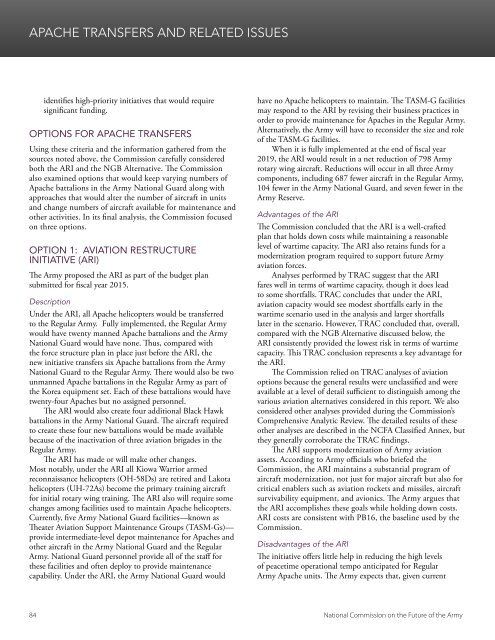THE FUTURE OF THE ARMY
1PlAz6L
1PlAz6L
Create successful ePaper yourself
Turn your PDF publications into a flip-book with our unique Google optimized e-Paper software.
APACHE TRANSFERS AND RELATED ISSUES<br />
identifies high-priority initiatives that would require<br />
significant funding.<br />
OPTIONS FOR APACHE TRANSFERS<br />
Using these criteria and the information gathered from the<br />
sources noted above, the Commission carefully considered<br />
both the ARI and the NGB Alternative. The Commission<br />
also examined options that would keep varying numbers of<br />
Apache battalions in the Army National Guard along with<br />
approaches that would alter the number of aircraft in units<br />
and change numbers of aircraft available for maintenance and<br />
other activities. In its final analysis, the Commission focused<br />
on three options.<br />
OPTION 1: AVIATION RESTRUCTURE<br />
INITIATIVE (ARI)<br />
The Army proposed the ARI as part of the budget plan<br />
submitted for fiscal year 2015.<br />
Description<br />
Under the ARI, all Apache helicopters would be transferred<br />
to the Regular Army. Fully implemented, the Regular Army<br />
would have twenty manned Apache battalions and the Army<br />
National Guard would have none. Thus, compared with<br />
the force structure plan in place just before the ARI, the<br />
new initiative transfers six Apache battalions from the Army<br />
National Guard to the Regular Army. There would also be two<br />
unmanned Apache battalions in the Regular Army as part of<br />
the Korea equipment set. Each of these battalions would have<br />
twenty-four Apaches but no assigned personnel.<br />
The ARI would also create four additional Black Hawk<br />
battalions in the Army National Guard. The aircraft required<br />
to create these four new battalions would be made available<br />
because of the inactivation of three aviation brigades in the<br />
Regular Army.<br />
The ARI has made or will make other changes.<br />
Most notably, under the ARI all Kiowa Warrior armed<br />
reconnaissance helicopters (OH-58Ds) are retired and Lakota<br />
helicopters (UH-72As) become the primary training aircraft<br />
for initial rotary wing training. The ARI also will require some<br />
changes among facilities used to maintain Apache helicopters.<br />
Currently, five Army National Guard facilities—known as<br />
Theater Aviation Support Maintenance Groups (TASM-Gs)—<br />
provide intermediate-level depot maintenance for Apaches and<br />
other aircraft in the Army National Guard and the Regular<br />
Army. National Guard personnel provide all of the staff for<br />
these facilities and often deploy to provide maintenance<br />
capability. Under the ARI, the Army National Guard would<br />
have no Apache helicopters to maintain. The TASM-G facilities<br />
may respond to the ARI by revising their business practices in<br />
order to provide maintenance for Apaches in the Regular Army.<br />
Alternatively, the Army will have to reconsider the size and role<br />
of the TASM-G facilities.<br />
When it is fully implemented at the end of fiscal year<br />
2019, the ARI would result in a net reduction of 798 Army<br />
rotary wing aircraft. Reductions will occur in all three Army<br />
components, including 687 fewer aircraft in the Regular Army,<br />
104 fewer in the Army National Guard, and seven fewer in the<br />
Army Reserve.<br />
Advantages of the ARI<br />
The Commission concluded that the ARI is a well-crafted<br />
plan that holds down costs while maintaining a reasonable<br />
level of wartime capacity. The ARI also retains funds for a<br />
modernization program required to support future Army<br />
aviation forces.<br />
Analyses performed by TRAC suggest that the ARI<br />
fares well in terms of wartime capacity, though it does lead<br />
to some shortfalls. TRAC concludes that under the ARI,<br />
aviation capacity would see modest shortfalls early in the<br />
wartime scenario used in the analysis and larger shortfalls<br />
later in the scenario. However, TRAC concluded that, overall,<br />
compared with the NGB Alternative discussed below, the<br />
ARI consistently provided the lowest risk in terms of wartime<br />
capacity. This TRAC conclusion represents a key advantage for<br />
the ARI.<br />
The Commission relied on TRAC analyses of aviation<br />
options because the general results were unclassified and were<br />
available at a level of detail sufficient to distinguish among the<br />
various aviation alternatives considered in this report. We also<br />
considered other analyses provided during the Commission’s<br />
Comprehensive Analytic Review. The detailed results of these<br />
other analyses are described in the NCFA Classified Annex, but<br />
they generally corroborate the TRAC findings.<br />
The ARI supports modernization of Army aviation<br />
assets. According to Army officials who briefed the<br />
Commission, the ARI maintains a substantial program of<br />
aircraft modernization, not just for major aircraft but also for<br />
critical enablers such as aviation rockets and missiles, aircraft<br />
survivability equipment, and avionics. The Army argues that<br />
the ARI accomplishes these goals while holding down costs.<br />
ARI costs are consistent with PB16, the baseline used by the<br />
Commission.<br />
Disadvantages of the ARI<br />
The initiative offers little help in reducing the high levels<br />
of peacetime operational tempo anticipated for Regular<br />
Army Apache units. The Army expects that, given current<br />
84 National Commission on the Future of the Army


